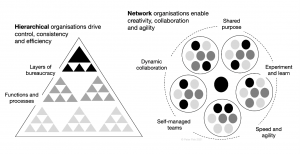The rise of ‘extreme teaming’ and the network-based organisational structure
Satya Nadella’s remarkable transformation of Microsoft into a $2 trillion company was possible by encouraging empowerment, openness, collaboration, experimentation, and learning. His most significant change, however, was the creation of a networked organisation structure. Frustrated by the politics and rigidity of the matrix organisation he inherited – with its cost centres, conflicting reporting lines and endless meetings – Nadella’s network-based system aimed to solve customer problems by using the best internal talent and external partners for each particular project. A seemingly complex spider’s web was, for the teams involved, simple, focussed and extraordinarily effective.
Networks, whether organisational or social, are powerful systems. Metcalfe’s Law (coined by 3M founder Robert Metcalfe) holds that “the value of a network is proportional to the square of its nodes”. Every additional participant creates new connections, capable of driving the exponential growth of today’s network-based start-ups.
This is a recent evolution. A decade ago, around 80% of employees had functional roles, the rest seconded to ad-hoc projects. Today, that ratio is reversed. Few employees now have fixed roles. Formal job titles in outdated organisational charts have given way to a more fluid deployment of talent, by project, to manage constant change.
Organisations also require more external help. Technical experts, short-term contractors and business partners bring resources and capabilities as and when projects demand, meshing with internal teams in a smart and agile ecosystem. Virtual networks quickly emerge across sectors and geographies, further accelerating progress.
At the heart of these network structures is “extreme teaming”. Empowered by leaders to deliver projects, teams are left to work out how. They assemble the best people for the job, energised by customers not managers, building psychological safety, and a collective commitment to deliver excellent, innovative results.

German pharmaceutical company BioNtech, for example, was able to build an ecosystem of global experts within days of the World Health Organisation’s Coronavirus alert, enabling the firm to develop and test a Covid vaccine within months, rather than decades. Buurtzorg, a Dutch elderly care business, swept away its process- and metric-driven model, to entrust teams with delivering care their own way within the budget. Zhang Ruimin, CEO of China’s home appliances giant Haier, went as far as creating some 10,000 start-up style micro-businesses, working independently but under the corporate umbrella, so they could be more creative and customer-centric. Empowerment has also been key for Haufe Group, a German software business where employees are encouraged to contribute to strategy, pay grades and performance are transparent, and every three years employees elect their CEO.
Organisation structures define companies – culturally and innovatively, revealing both opportunities and limitations. Henry Ford’s hierarchical business model that produced low-cost cars a century ago no longer reflects today’s organisational needs: to be fast and agile, human and technological, collaborative and creative, personal and global.
As Peter Drucker once remarked: “the purpose of an organisation is to enable ordinary human being to do extraordinary things.” There are many useful organisation theories, models and approaches to help companies evolve to make this happen.
Related Case Study: How BBVA created an ecosystem of innovation in banking
Finding ways not only to be innovative, sustainable and to contribute to society in meaningful ways is still challenging. Most organisations want to find innovative ways of growing and to give back, but how do you ensure you leverage your own expertise to maximize the value for the community? To meet some of these objectives, BBVA partnered with Headspring to build a program to upskill and support social entrepreneurs. Read the full case study here.
